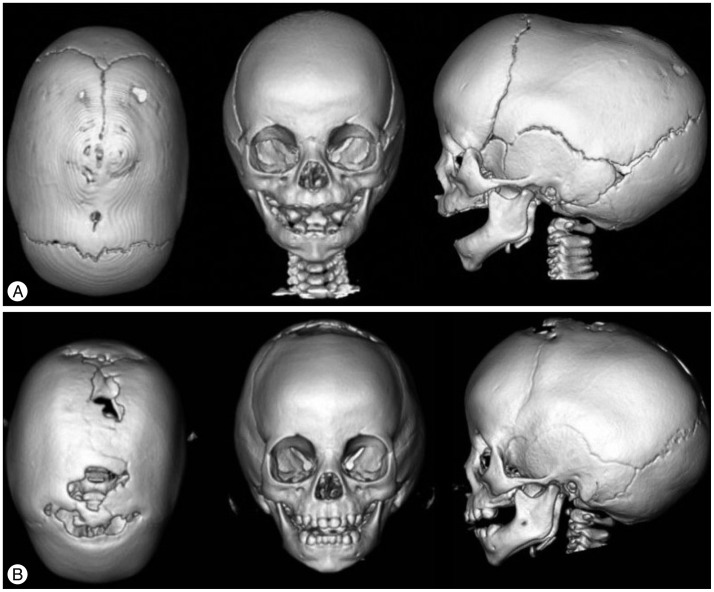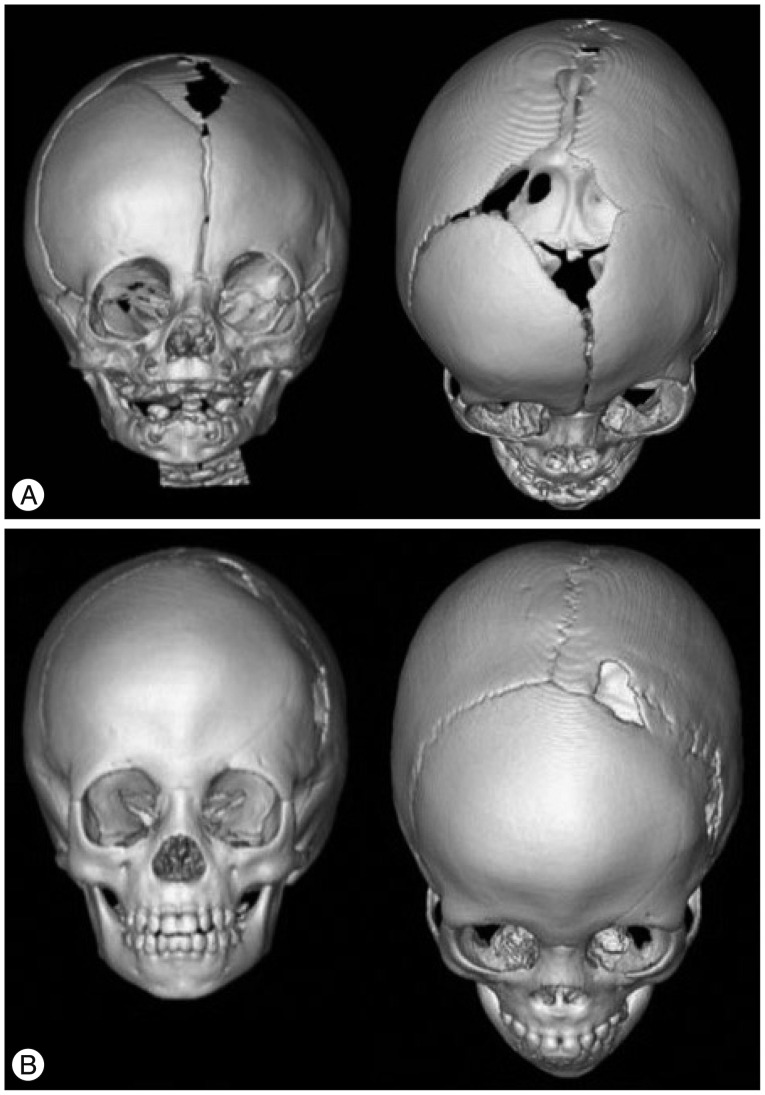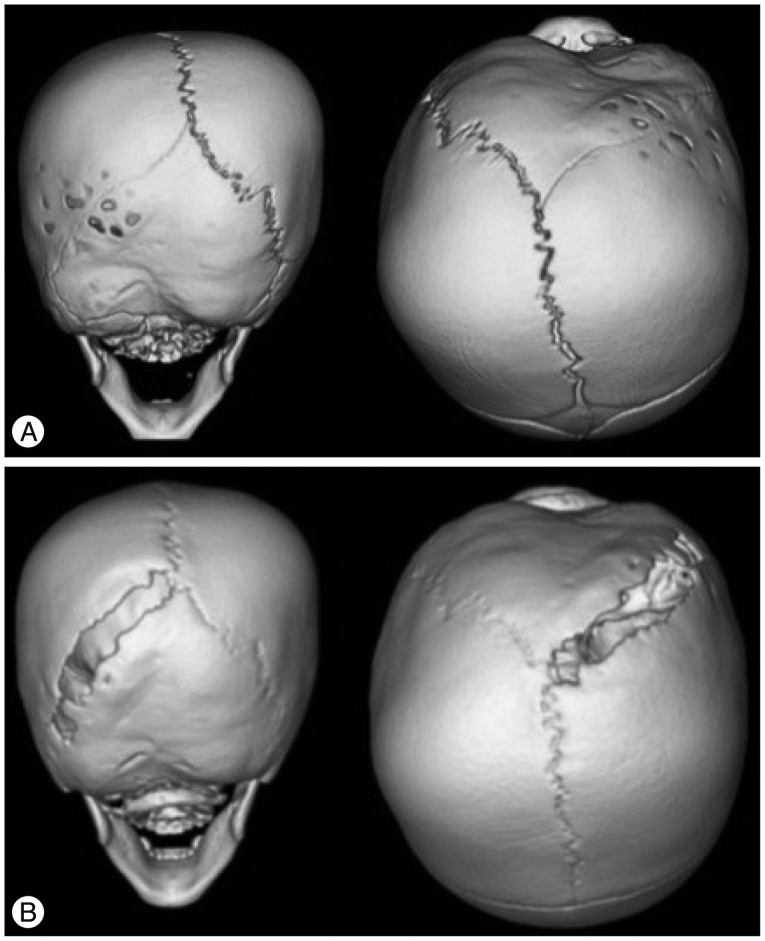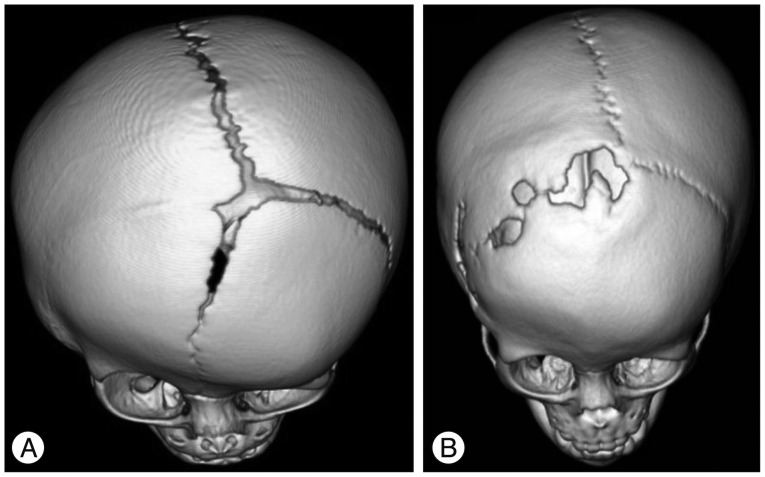1. Agrawal D, Steinbok P, Cochrane DD. Long-term anthropometric outcomes following surgery for isolated sagittal craniosynostosis. J Neurosurg. 2006; 105(5 Suppl):357–360. PMID:
17328257.

2. Akai T, Iizuka H, Kawakami S. Treatment of craniosynostosis by distraction osteogenesis. Pediatr Neurosurg. 2006; 42:288–292. PMID:
16902340.

3. Boop FA, Chadduck WM, Shewmake K, Teo C. Outcome analysis of 85 patients undergoing the pi procedure for correction of sagittal synostosis. J Neurosurg. 1996; 85:50–55. PMID:
8683282.

4. Clayman MA, Murad GJ, Steele MH, Seagle MB, Pincus DW. History of craniosynostosis surgery and the evolution of minimally invasive endoscopic techniques : the University of Florida experience. Ann Plast Surg. 2007; 58:285–287. PMID:
17471133.

5. Denis D, Genitori L, Bolufer A, Lena G, Saracco JB, Choux M. Refractive error and ocular motility in plagiocephaly. Childs Nerv Syst. 1994; 10:210–216. PMID:
7923229.

6. Eppley BL, Sadove AM, Havlik RJ. Resorbable plate fixation in pediatric craniofacial surgery. Plast Reconstr Surg. 1997; 100:1–7. discussion 8-13. PMID:
9207653.

7. Esparza J, Hinojosa J. Complications in the surgical treatment of craniosynostosis and craniofacial syndromes : apropos of 306 transcranial procedures. Childs Nerv Syst. 2008; 24:1421–1430. PMID:
18769932.

8. Faber HK, Towne EB. Early craniectomy as a preventive measure in oxycephaly and allied conditions. Am J Med Sci. 1927; 173:701–711.

9. Faberowski LW, Black S, Mickle JP. Blood loss and transfusion practice in the perioperative management of craniosynostosis repair. J Neurosurg Anesthesiol. 1999; 11:167–172. PMID:
10414670.

10. Fearon JA, Weinthal J. The use of recombinant erythropoietin in the reduction of blood transfusion rates in craniosynostosis repair in infants and children. Plast Reconstr Surg. 2002; 109:2190–2196. PMID:
12045535.

11. Heller JB, Heller MM, Knoll B, Gabbay JS, Duncan C, Persing JA. Intracranial volume and cephalic index outcomes for total calvarial reconstruction among nonsyndromic sagittal synostosis patients. Plast Reconstr Surg. 2008; 121:187–195. PMID:
18176220.

12. Hinojosa J, Esparza J, Muñoz MJ. Endoscopic-assisted osteotomies for the treatment of craniosynostosis. Childs Nerv Syst. 2007; 23:1421–1430. PMID:
17899127.

13. Jimenez DF, Barone CM. Early treatment of anterior calvarial craniosynostosis using endoscopic-assisted minimally invasive techniques. Childs Nerv Syst. 2007; 23:1411–1419. PMID:
17899128.

14. Jimenez DF, Barone CM. Early treatment of coronal synostosis with endoscopy-assisted craniectomy and postoperative cranial orthosis therapy : 16-year experience. J Neurosurg Pediatr. 2013; 12:207–219. PMID:
23808724.

15. Jimenez DF, Barone CM. Endoscopic craniectomy for early surgical correction of sagittal craniosynostosis. J Neurosurg. 1998; 88:77–81. PMID:
9420076.

16. Jimenez DF, Barone CM. Endoscopic technique for sagittal synostosis. Childs Nerv Syst. 2012; 28:1333–1339. PMID:
22872245.

17. Jimenez DF, Barone CM. Intraoperative autologous blood transfusion in the surgical correction of craniosynostosis. Neurosurgery. 1995; 37:1075–1079. PMID:
8584147.

18. Jimenez DF, Barone CM. Multiple-suture nonsyndromic craniosynostosis : early and effective management using endoscopic techniques. J Neurosurg Pediatr. 2010; 5:223–231. PMID:
20192637.

19. Jimenez DF, Barone CM, McGee ME, Cartwright CC, Baker CL. Endoscopy-assisted wide-vertex craniectomy, barrel stave osteotomies, and postoperative helmet molding therapy in the management of sagittal suture craniosynostosis. J Neurosurg. 2004; 100(5 Suppl Pediatrics):407–417. PMID:
15287447.

20. Kearney RA, Rosales JK, Howes WJ. Craniosynostosis : an assessment of blood loss and transfusion practices. Can J Anaesth. 1989; 36:473–477. PMID:
2758548.

21. Kumar AV, Staffenberg DA, Petronio JA, Wood RJ. Bioabsorbable plates and screws in pediatric craniofacial surgery : a review of 22 cases. J Craniofac Surg. 1997; 8:97–99. PMID:
10332274.
22. Lannelongue M. De la craniectomie dans la microcéphalie. Compt Rend Seances Acad Sci. 1890; 50:1382–1385.
23. Macintosh C, Wall S, Leach C. Strabismus in unicoronal synostosis : ipsilateral or contralateral? J Craniofac Surg. 2007; 18:465–469. PMID:
17538304.
24. MacKinnon S, Rogers GF, Gregas M, Proctor MR, Mulliken JB, Dagi LR. Treatment of unilateral coronal synostosis by endoscopic strip craniectomy or fronto-orbital advancement : ophthalmologic findings. J AAPOS. 2009; 13:155–160. PMID:
19393513.

25. Marsh JL, Jenny A, Galic M, Picker S, Vannier MW. Surgical management of sagittal synostosis. A quantitative evaluation of two techniques. Neurosurg Clin N Am. 1991; 2:629–640. PMID:
1821309.
26. Maugans TA, McComb JG, Levy ML. Surgical management of sagittal synostosis : a comparative analysis of strip craniectomy and calvarial vault remodeling. Pediatr Neurosurg. 1997; 27:137–148. PMID:
9548524.

27. Murad GJ, Clayman M, Seagle MB, White S, Perkins LA, Pincus DW. Endoscopic-assisted repair of craniosynostosis. Neurosurg Focus. 2005; 19:E6. PMID:
16398483.

28. Panchal J, Marsh JL, Park TS, Kaufman B, Pilgram T, Huang SH. Sagittal craniosynostosis outcome assessment for two methods and timings of intervention. Plast Reconstr Surg. 1999; 103:1574–1584. PMID:
10323690.

29. Persing J, Babler W, Winn HR, Jane J, Rodeheaver G. Age as a critical factor in the success of surgical correction of craniosynostosis. J Neurosurg. 1981; 54:601–606. PMID:
7014791.

30. Proctor MR. Endoscopic craniosynostosis repair. Transl Pediatr. 2014; 3:247–258. PMID:
26835342.
31. Ridgway EB, Berry-Candelario J, Grondin RT, Rogers GF, Proctor MR. The management of sagittal synostosis using endoscopic suturectomy and postoperative helmet therapy. J Neurosurg Pediatr. 2011; 7:620–626. PMID:
21631199.

32. Rivero-Garvía M, Marquez-Rivas J, Rueda-Torres AB, Ollero-Ortiz A. Early endoscopy-assisted treatment of multiple-suture craniosynostosis. Childs Nerv Syst. 2012; 28:427–431. PMID:
22038155.

33. Seymour-Dempsey K, Baumgartner JE, Teichgraeber JF, Xia JJ, Waller AL, Gateno J. Molding helmet therapy in the management of sagittal synostosis. J Craniofac Surg. 2002; 13:631–635. PMID:
12218789.

34. Shah MN, Kane AA, Petersen JD, Woo AS, Naidoo SD, Smyth MD. Endoscopically assisted versus open repair of sagittal craniosynostosis : the St. Louis Children's Hospital experience. J Neurosurg Pediatr. 2011; 8:165–170. PMID:
21806358.

35. Shillito J Jr, Matson DD. Craniosynostosis : a review of 519 surgical patients. Pediatrics. 1968; 41:829–853. PMID:
5643989.
36. Sugawara Y, Hirabayashi S, Sakurai A, Harii K. Gradual cranial vault expansion for the treatment of craniofacial synostosis : a preliminary report. Ann Plast Surg. 1998; 40:554–565. PMID:
9600446.

37. Tan SP, Proctor MR, Mulliken JB, Rogers GF. Early frontofacial symmetry after correction of unilateral coronal synostosis : frontoorbital advancement vs endoscopic strip craniectomy and helmet therapy. J Craniofac Surg. 2013; 24:1190–1194. PMID:
23851767.

38. Whitaker LA, Bartlett SP, Schut L, Bruce D. Craniosynostosis : an analysis of the timing, treatment, and complications in 164 consecutive patients. Plast Reconstr Surg. 1987; 80:195–212. PMID:
3602170.
39. White N, Evans M, Dover MS, Noons P, Solanki G, Nishikawa H. Posterior calvarial vault expansion using distraction osteogenesis. Childs Nerv Syst. 2009; 25:231–236. PMID:
19057909.

40. Zubovic E, Woo AS, Skolnick GB, Naidoo SD, Smyth MD, Patel KB. Cranial base and posterior cranial vault asymmetry after open and endoscopic repair of isolated lambdoid craniosynostosis. J Craniofac Surg. 2015; 26:1568–1573. PMID:
26114505.








 PDF
PDF ePub
ePub Citation
Citation Print
Print



 XML Download
XML Download